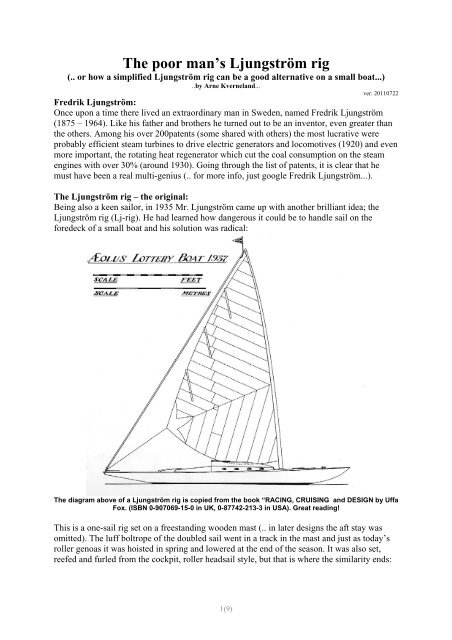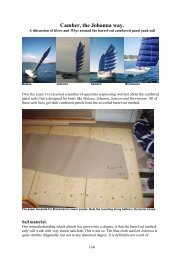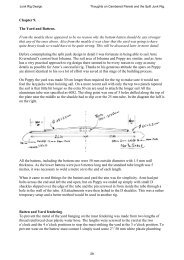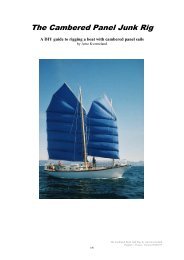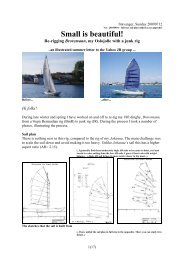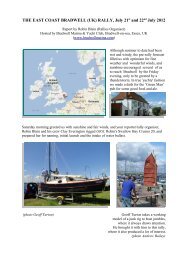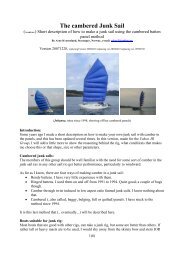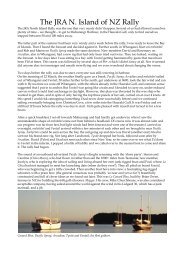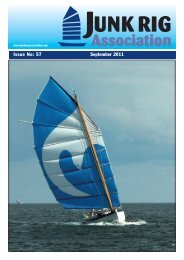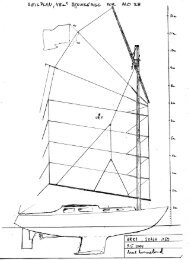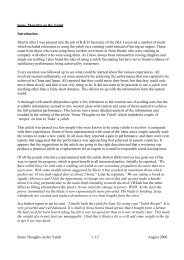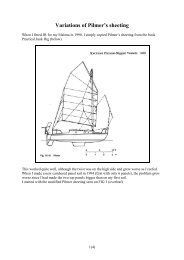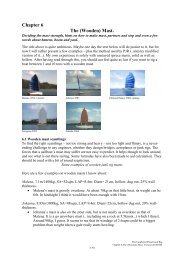The poor man's Ljungström rig - The Junk Rig Association
The poor man's Ljungström rig - The Junk Rig Association
The poor man's Ljungström rig - The Junk Rig Association
Create successful ePaper yourself
Turn your PDF publications into a flip-book with our unique Google optimized e-Paper software.
<strong>The</strong> <strong>poor</strong> man’s <strong>Ljungström</strong> <strong>rig</strong><br />
(.. or how a simplified <strong>Ljungström</strong> <strong>rig</strong> can be a good alternative on a small boat...)<br />
..by Arne Kverneland...<br />
ver. 20110722<br />
Fredrik <strong>Ljungström</strong>:<br />
Once upon a time there lived an extraordinary man in Sweden, named Fredrik <strong>Ljungström</strong><br />
(1875 – 1964). Like his father and brothers he turned out to be an inventor, even greater than<br />
the others. Among his over 200patents (some shared with others) the most lucrative were<br />
probably efficient steam turbines to drive electric generators and locomotives (1920) and even<br />
more important, the rotating heat regenerator which cut the coal consumption on the steam<br />
engines with over 30% (around 1930). Going through the list of patents, it is clear that he<br />
must have been a real multi-genius (.. for more info, just google Fredrik <strong>Ljungström</strong>...).<br />
<strong>The</strong> <strong>Ljungström</strong> <strong>rig</strong> – the o<strong>rig</strong>inal:<br />
Being also a keen sailor, in 1935 Mr. <strong>Ljungström</strong> came up with another brilliant idea; the<br />
<strong>Ljungström</strong> <strong>rig</strong> (Lj-<strong>rig</strong>). He had learned how dangerous it could be to handle sail on the<br />
foredeck of a small boat and his solution was radical:<br />
<strong>The</strong> diagram above of a <strong>Ljungström</strong> <strong>rig</strong> is copied from the book “RACING, CRUISING and DESIGN by Uffa<br />
Fox. (ISBN 0-907069-15-0 in UK, 0-87742-213-3 in USA). Great reading!<br />
This is a one-sail <strong>rig</strong> set on a freestanding wooden mast (.. in later designs the aft stay was<br />
omitted). <strong>The</strong> luff boltrope of the doubled sail went in a track in the mast and just as today’s<br />
roller genoas it was hoisted in spring and lowered at the end of the season. It was also set,<br />
reefed and furled from the cockpit, roller headsail style, but that is where the similarity ends:<br />
1(9)
<strong>The</strong> Lj-sail was self-tacking, at least on short tacks. On longer tacks the mast was rotated until<br />
the mast track was almost pointing forward to create a very smooth lee side behind the luff.<br />
<strong>The</strong> figure above shows how the mast is rotated to give optimal airflow over the leeside of the sail. This<br />
diagram is copied from “SAILING THEORY AND PRACTICE” by C.A. Marchaj (ISBN 0 229 11665 5)<br />
Marchaj’s diagram above also shows how the whole free-standing mast is used as a big roller<br />
reefing device. <strong>Ljungström</strong> made it work by using big ball bearings both at the mast step and<br />
at the partners. A big pulley clamped to the mast just below deck lets one rotate the mast from<br />
the helmsman’s position.<br />
This <strong>rig</strong> is in my eyes very close to being the ultimate one, at least for close-hauled sailing:<br />
Practical sailing proved that it could sail faster and closer to the wind than even the best<br />
Bermuda <strong>rig</strong>s. This has been confirmed by aerodynamic tests done by Mr Marchaj. In<br />
addition it proved to be safe in the sometimes windy conditions on the west coast of Sweden.<br />
<strong>Ljungström</strong> himself kept on sailing his boat, often alone, until he was quite old – which would<br />
have been totally impossible with a Bermuda <strong>rig</strong>.<br />
2(9)
This shows the Lj-<strong>rig</strong> in two modes: To the left the double sail is closed while to the <strong>rig</strong>ht one can see<br />
how the sail has been folded open on a dead run (from Marchaj).<br />
So why doesn’t my Malena sail with a <strong>Ljungström</strong> <strong>rig</strong> today if it is that good?<br />
..read on...<br />
Malena, searching for a better <strong>rig</strong> for her:<br />
(..Malena, mine between 1981 – 99, was o<strong>rig</strong>inally <strong>rig</strong>ged with a masthead Bermuda <strong>rig</strong>...)<br />
After my first real venture offshore in Malena in 1983, from Stavanger to Skagen in<br />
Denmark, I concluded that working on the foredeck of a small boat wasn’t always fun.<br />
Malena then sailed a summer with a gaff sail.<br />
<strong>The</strong> 23’ Albin Viggen, Malena with a gaff mainsail fitted in 1985. Note the position of the 3 rd reef...<br />
3(9)
<strong>The</strong> conversion to gaff wasn’t as illogical as it may seem. <strong>The</strong> mainsail’s area was nearly<br />
doubled which meant that the genoas could be brought ashore for good. A new high-clewed<br />
working jib could be fitted on a roll and free me from deck work. <strong>The</strong> mainsail gave great<br />
drive both up- and downwind. Setting and reefing it had to be done at the mast but that was no<br />
problem – it was the foredeck work I didn’t like; changing or reefing jibs. Still, I kept on<br />
searching for something even easier...<br />
For a period my sketchbook was filled with cat<strong>rig</strong>s like those above. If I had not come across<br />
the junk<strong>rig</strong> later, I would probably have landed on a gaff cat<strong>rig</strong>, slightly less radical than the<br />
one above. It would save a lot mast-height, about 2.5m compared to the Bermuda version.<br />
Still not totally happy, I kept on searching...<br />
4(9)
<strong>The</strong> diagrams (above) showing my versions of the Lj-<strong>rig</strong> were lying on my desk for a good<br />
while. Analysing the <strong>rig</strong>, some problems became apparent:<br />
• It wouldn’t be easy to accommodate a large enough <strong>rig</strong> on such a short boat. <strong>The</strong> Lj-<strong>rig</strong><br />
used to be fitted to long skinny boats of low displacement and with plenty of space for<br />
sheeting.<br />
• To make the sail work better on a reach and run, a boom or something would be needed;<br />
not easy to fit with a rotating mast.<br />
• <strong>The</strong> sail centre (CE) would move a lot as the sail was reefed. This could be a problem<br />
unless I fitted a mizzen (<strong>Ljungström</strong> even made the mast step moveable on some boats to<br />
trim the balance)<br />
• I had no idea about unstayed masts at the time so fitting such a tall mast would be a<br />
challenge.<br />
• <strong>The</strong> roller reefing bearings at the maststep and partners would call for outside help to<br />
make.<br />
So I gave it up. Luckily I got my hands on the Practical <strong>Junk</strong> <strong>Rig</strong> book in 1989 and from then<br />
on it was plain (JR) sailing. Malena’s present mast is only 9.4m tall, but still gives room for a<br />
32sqm JR sail (below).<br />
(Photo: Andrew Bailey, 2010)<br />
.. ragged glory. <strong>The</strong> sail from 1994 has big holes in it, but that doesn’t seem to affect its performance...<br />
5(9)
<strong>The</strong> <strong>poor</strong> man’s <strong>Ljungström</strong> <strong>rig</strong>:<br />
While sketching all sorts of <strong>rig</strong>s for Malena, I actually designed and made a much simplified<br />
Lj-<strong>rig</strong> and fitted it to a friend’s rowboat. Its sail wasn’t doubled as were most of <strong>Ljungström</strong>’s<br />
o<strong>rig</strong>inals, and there were no ball bearings or roller reefing pulley on the mast either.<br />
.. the very rough sketch from which the <strong>poor</strong> man’s Lj-sail was made...<br />
As can be seen from the sketch, the sail was given a generous roach on the leech and this<br />
added to the sail area while saving mast height. <strong>The</strong> result can be seen on next page...<br />
6(9)
(Photos: Slieve McGalliard, 2004)<br />
.. Curtiss with his Lj-<strong>rig</strong>ged rowboat (LOA=4.9m, SA =7.4sqm, mast 5.5m/7.0cm)..<br />
.. he sailed over to greet the first JRA-rally in Stavanger in 2004. <strong>The</strong> <strong>rig</strong> was then 18 years old...<br />
Some more construction and <strong>rig</strong>ging details of the simplified Lj-<strong>rig</strong>;<br />
<strong>The</strong> <strong>poor</strong> man’s <strong>Ljungström</strong> <strong>rig</strong>:<br />
• <strong>The</strong> mast was not meant to be rotated for perfect setting after each tacking like the<br />
mast of the o<strong>rig</strong>inal Lj-<strong>rig</strong> was. For this reason this sail was simply laced to the mast.<br />
No mast track or halyard was needed.<br />
• <strong>The</strong> sail was cut flat with a straight luff. Camber can be varied by how the sail is<br />
sheeted.<br />
7(9)
• To support the generous roach the sail was fitted with two full-length battens along the<br />
mast. <strong>The</strong>se were positioned only after the trial-installation of the sail and rolling it up<br />
on the mast. If you look carefully on the photos, you will notice that the batten pockets<br />
are not fully parallel with the mast: With the mast being almost twice as thick at the<br />
partners as in the top, the sail will of course be rolled in faster in the lower end.<br />
• <strong>The</strong> mast rake was found by trial and error. <strong>The</strong> gunwale-to-gunwale mast thwart was<br />
just held in place with clamps on the first trip. <strong>The</strong> final position which gave easy<br />
steering shows quite some aft rake of the mast. Luckily I had cut the sail with a high<br />
clew, so the end result didn’t look so bad.<br />
Sailing the <strong>poor</strong> man’s <strong>Ljungström</strong> <strong>rig</strong>:<br />
First of all, the mast and sail sums up to about 10kg so most people can raise the mast easily.<br />
<strong>The</strong> mast fits into a square mast step. A 10mm bolt is screwed into the root end of the mast,<br />
<strong>rig</strong>ht in the centre, and the bolt head is cut off, leaving about 20mm sticking out.<br />
When rolling out or in some sail, the mast is lifted out just enough to get the square end free<br />
from the step, but with the bolt still holding the mast from falling totally out of it. In this<br />
position it is easy to revolve the mast by hand. <strong>The</strong>n the mast is dropped back in the mast step.<br />
With a little practice, this is a quite easy and fast method for setting, reefing and furling the<br />
sail.<br />
<strong>The</strong> only running line in this <strong>rig</strong> is a single jib-style sheet. On the inside of each gunwale a<br />
number of thumb cleats have been screwed on. <strong>The</strong> sheet is passed over one of these which<br />
fits the sailing and sail area at the moment and which gives the <strong>rig</strong>ht twist. When tacking, the<br />
helmsman just moves the sheet over to a cleat on the other side; quick and simple.<br />
<strong>The</strong> performance of this <strong>rig</strong> has proven to be very good. I have tried to sail many rowboats to<br />
windward, both with sprit- or gaff-sloop <strong>rig</strong>s and also one with a sprit-sail cat <strong>rig</strong>. To be<br />
honest; their upwind progress was not much to write home and tell about.<br />
(.. Norwegian rowboats in the færing tradition were never meant to be<br />
sailed to windward so they only have a 3-4” deep full length keel...)<br />
<strong>The</strong> Lj-<strong>rig</strong> is no doubt better than all the others I have tried – with a big margin. One really<br />
makes progress to windward with that <strong>rig</strong>. Another fine thing is that it seems to produce less<br />
heeling moment than the others. I guess this has to do with the pronounced mast rake which<br />
actually shortens the heeling lever compared to that of a vertical mast.<br />
Summing up:<br />
<strong>The</strong> <strong>poor</strong> man’s Lj-<strong>rig</strong> for small boats is both cheap and easy to make and also easy to <strong>rig</strong> and<br />
handle. <strong>The</strong> furled bundle is very tidy and will not flog about when stored or when being<br />
trailed. Its combination of economy, performance and safety in use is simply hard to beat.<br />
I am undecided on how far one can expand this mini Lj-<strong>rig</strong> until it starts to get too heavy and<br />
complicated, but as long as it can be man-handled in this rowboat fashion (up to 10sqm?), it<br />
should be among the cheapest and simplest <strong>rig</strong> you can get.<br />
I am happy with the two full-length battens: <strong>The</strong>y save mast length and the sail also seems to<br />
be more docile when left flying than jibs do.<br />
Could this be something for your dinghy, dory, skiff or færing?? It’s up to you now...<br />
Stavanger, 11 th July 2011<br />
Arne Kverneland<br />
PS: But now have a look on next page...<br />
8(9)
Lj-<strong>rig</strong> reborn?<br />
A couple of weeks ago I stumbled over an article where two small trailable cruisers were<br />
tested. One of them was new to me; a French twin-keeler, Ocqueteau Tilapia 6.50, with only<br />
60cm draught. <strong>The</strong> test crew became very surprised and impressed over how quick and closewinded<br />
this wide-body hull with twin keels and rudders was.<br />
Ocqueteau Tilapia 6.50<br />
I took the photo above from a videoclip I found on Youtube. Look up:<br />
http://www.youtube.com/watch?v=CP4d4IXEaK0 ...<br />
.. or simply go to YouTube and search for Tilapia 6.5.<br />
I have no idea if the builders know about <strong>Ljungström</strong> and his <strong>rig</strong>s; maybe they have just reinvented<br />
the <strong>rig</strong>. Today, after 30years with the freestanding Freedom <strong>rig</strong> and with roller<br />
reefing headsails, plus the advent of more affordable carbon masts, this <strong>rig</strong> is a natural step<br />
forward, not so radical at all. Fredrik <strong>Ljungström</strong> just happened to be 70 years ahead of his<br />
time...<br />
This full size Lj-<strong>rig</strong> is obviously more hi-tech to make and therefore better suited for<br />
professional production. My <strong>poor</strong> man’s version of the Lj-<strong>rig</strong> is just meant for us humble<br />
DIY-ers and our dinghies...<br />
Enjoy the videoclip. <strong>The</strong> music following it may be more affordable than the boat. It is clips<br />
from the “Peer Gynt Suite” by Edvard Grieg...<br />
9(9)


